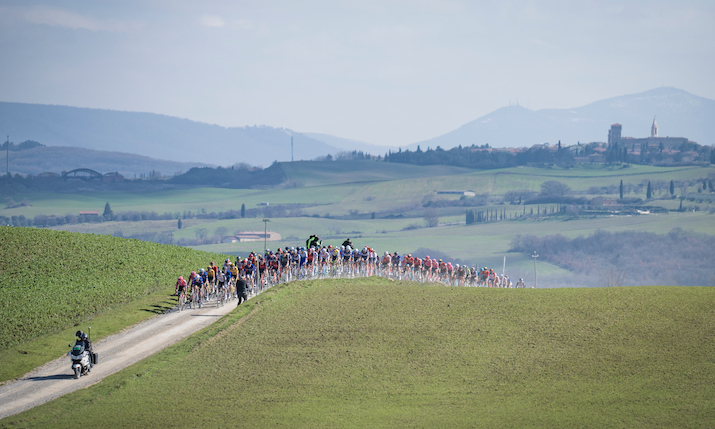EMG Italy and RCS Sport battle the elements to deliver a quartet of UCI World Tour races to global viewers

On the road during the Strade Bianche [Picture: kramon]
In the first part of an in-depth look at the work that EMG Italy and RCS Sport did on four high-profile UCI World Tour cycling races held in Italy earlier this month, the focus is on the technical innovations introduced for the 2023 edition.
International cycling returned to Italy with the classic Strade Bianche, which takes place every year in the hills of Siena and involves the arrival in the incredible setting of the Piazza del Campo. This unique race is followed by the seven-day Tirreno-Adriatico, the Milan-Turin and finally by the best known and most important competition, the Milan-San Remo.
RCS Sport manages all of these events and owns the rights. For the second year, the company worked with EMG Group to co-produce all UCI World Tour races in Italy, benefiting from the technical and editorial expertise EMG has developed from working on major international cycling races for many years.
Communication and production
“EMG needs no introduction in the international broadcast sector and EMG Italy is the reference for the Italian market for its multiple manufacturing capabilities in every sector of communication and production,” says Davide Furlan, outdoor production director, EMG Italy.
“Our proprietary technical infrastructures and our specialised professionals allow us to propose ourselves as a global partner for different types of live events, in sports and entertainment.”
EMG Italy was responsible for the complete technical/production management and management control of the cycling event for the group, which Furlan says is “a real source of pride and a great effort considering the multiple other major events taking place at the same time, such as the Superbike World Championship, with stops in Australia and Indonesia, and the Ski World Cup Finals in Andorra”.

Super slow-motion Sony 4300 HFRs were among the cameras used along the routes
“World Tour cycling has a technical/editorial and production standard that only big companies like EMG can guarantee, there are many economic interests at stake and expectations are very high,” he continues.
“Producing these great cycling events makes us very proud of our work: the races take place over a truly impressive radius, straddling different regions and with incredible atmospheric excursions; they require very high-quality images and sounds that travel along the most beautiful roads in the world, and live shooting with impressive stability.
“In just one day you can easily move from snow on the passes to the scorching sun along the coasts, to rain and 120km/h wind, which in one test in particular [arrival in Sassotetto during the Tirreno-Adriatico] forced RCS to move 2.5km further downstream as the wind was blowing too hard at the original high-altitude finish.”
Production innovations
One of the innovations introduced by EMG Italy for this season was the use of the group’s proprietary OL270 vehicles, supplied by the Dutch division of EMG Connectivity.
These were deployed to connect the satellites and enable the retransmission of signals received from the motorbikes capturing the action towards the intermediate stations and the TV compound, and vice versa.
As was the case in 2022, EMG Italy was also involved on an editorial level and Belgian director Gunther Herregodts, an EMG collaborator who has worked on major events including Tour of Flanders, the Olympics, and other UCI World Tours, worked on board the mobile vehicles.
The setup on the ground
The production effort was extensive, with 125 technical crew employed at each event, including EVS operators, motorcycle operators and drivers. The Orion 209 main gallery mobile vehicle, deployed at each arrival, featured a Kahuna mixer and four EVS XT-VIA stations with 14 channels each on board.
Eleven cameras were placed in the final area, two of which were super slow-motion Sony 4300 HFR, and a POV micro camera was used for the photo finish. Cameras were used to narrate the last kilometre, the arrival, the podium, for interviews, and for colour images. Each camera also picked up two audio signals in stereo, embedded audio.
On board the vehicle following each race were the director, assistant director, video mixer, three EVS operators, three camera controls, and two content editors for post-production. Two Avid consoles in the EVS network created clips that were instantly available for news feeds, magazines and highlights.
RCS also worked on expanding and enhancing its social offering, with a view to reaching full capacity at the Giro d’Italia.

